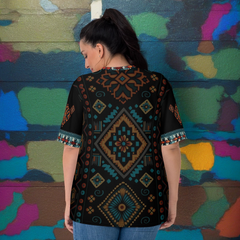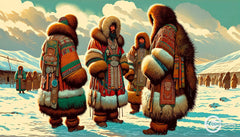The History And Craftsmanship Of The Yakut Knife
Posted by Massimiliano Geraci

Exploring the world of traditional knives, one may often seek a blade that not only promises exceptional performance but also carries a story steeped in history. The search for such craftsmanship might lead you to the rugged and remote landscapes of Siberia, where the Yakut knife has been a vital tool and cultural icon for centuries.
Perhaps you're an enthusiast looking to enrich your collection or needing a robust companion for your wilderness adventures — this unique blade could be what's missing from your kit.
The Yakut knife isn't just any piece of cutlery; it's a testament to the skillful artistry of Sakha metalworkers who have preserved its design, virtually unchanged through generations.
This remarkable consistency offers you not just a knife, but an authentic slice of tribal heritage. Our blog will guide you through its intriguing past, shed light on its distinctive creation process and reveal why this heirloom commands attention in today’s modern age.
Discover how owning one can elevate both your outdoor endeavors and spiritual connection to ancestral craftsmanship.
Ready? Let’s carve into history together!

The Rich History of the Yakut Knife
Delving into the historical tapestry of the Yakut knife reveals a saga steeped in cultural heritage, where each blade's echo reflects the heartbeat of ancient Siberia. This venerable cutting tool carries stories of survival and skill passed down through generations, evolving even as it preserves its timeless essence amidst the frozen landscapes from which it springs.
Origins and Traditional Use
The Yakutian knife emerges from the frigid expanses of Siberia, a testament to the ingenuity of the Yakut people. Forged by skilled blacksmiths using time-honored methods, these knives were essential for survival amid challenging conditions.
Carrying one signified readiness to whittle wood, skin game, or fillet fish—vital tasks in daily life that required a reliable tool. The unique asymmetrical blade design with its chisel grind and convex edge enhanced both functionality and durability.
Crafted originally from iron ore mined locally in the Sakha Republic region, each knife connects deeply to its place of origin. Birch burl provided a natural handle material, warm to touch even at sub-zero temperatures—a crucial feature for hands engaged in bushcraft or hunting.
Rich tradition imbued every element of these knives with meaning well beyond mere utility; they represented connection—to land, culture, and family lineage spanning generations.
Moving on from these historical roots reveals how family tradition has shaped the modern evolution of this ethnic treasure.
Family Tradition and Evolution
Tracing the lineage of the Yakut knife reveals a tapestry woven with dedication to age-old methods. Craftspeople in Siberia honor their ancestors by hand-forging these remarkable blades, preserving skills that have been handed down through generations.
This commitment keeps the spirit and essence of traditional Yakut craftsmanship alive despite modern advancements.
The evolution of this art form is evident as each craftsman introduces subtle improvements while respecting the core design that has stood the test of time. These knives are not just tools but symbols of cultural endurance, embodying both functionality and heritage.
As newer generations embrace these practices, they ensure that the unique identity and legacy of Siberian knifemaking continue to thrive in today's world.

The Art of Crafting a Yakut Knife
Delving into the artistry behind a Yakut knife reveals a fusion of ancestral wisdom and metallurgical precision, capturing both the spirit and resilience of Siberian culture. Master artisans hand-forge these remarkable tools, meticulously shaping high-carbon steel to create blades renowned for their durability and exceptional edge retention.
Select Materials and Forging Techniques
Crafting a traditional Yakut knife requires choosing the right steel to ensure durability and performance. Blacksmiths often select 420HC stainless steel for its corrosion resistance, SAE52100 high carbon steel for exceptional hardness, or O1 tool steel renowned for excellent wear resistance.
Each type of steel brings unique benefits to the table and is chosen based on the intended use of the knife—be it for intricate wood carving or robust bushcraft tasks.
The forging process itself is an art passed down through generations. Master smiths hand forge each blade, carefully controlling heat treatment to achieve a balance between toughness and edge retention.
They work meticulously to shape the distinctive features of a Yakut knife, like its asymmetrical bevel that allows precise cutting strokes perfect for slicing fish and meat or creating detailed crafts from birch bark or mammoth ivory sought after by collectors and outdoor enthusiasts alike.
Unique Features: Siberian Mammoth Tusk Handles
Siberian mammoth tusk handles elevate the Yakut knife from a simple tool to an extraordinary piece of history and artistry. Each handle, shaped from ancient ivory, connects you to the prehistoric past of the majestic Siberian wilderness.
The smooth curves and rich texture make for an exceptional grip that is also immune to the bitter cold that would radiate from metal.
Craftsmen select these rare tusks with care, ensuring they enhance both the aesthetic beauty and functionality of each knife. Imagine holding a slice of ice age splendor as you carve through wood or skin hides—these knives don't just perform tasks; they tell stories.
With every use, your connection deepens not only to the materials but also to the indigenous cultures and spiritual traditions tied to this magnificent region of Siberia.















